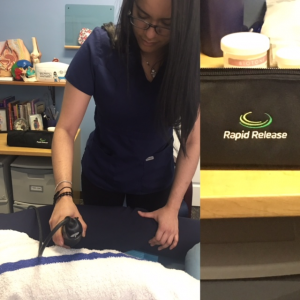We sometimes use this device to apply mild heat and vibration to help relax the muscles. Using small strokes at high frequency this device can induce relaxation of the painful muscle rapidly. It has several different treatment “heads” designed for either treating bony contours, myofascial trigger points, or larger muscle bellies.

In this image we are utilizing the Rapid Release on the hip adductors. This is a large inner thigh muscle group comprised of 5 muscles: the pectineus, adductor magnus, brevity, longus, and gracilis. There is a shared connection with the obturator externus. This muscle group is predominantly innervated by the obturator nerve. The adductors attach onto the pubis superiorly and share fascial connection with the pelvic floor muscles. Thus, using high frequency vibrational therapy can result in relaxing the hip adductors and gain secondary relaxation of the pelvic floor muscles. Furthermore, because of the anatomical relationship to the deep hip rotators including the obturator externus and internus, piriformis, and gemelli there can also be another gain of relaxation of this muscle group. We can also use the device on these adjunct muscles externally for a more direct approach.
We provide one-on-one treatment with primarily manual therapies, so this device is only a small adjunct modality used sparingly on those who qualify (and like the sensation). It is extremely vibratory. Studies have shown that vibration can relax muscles, down-regulate the nervous system for a relaxed overall body sensation, and improve circulation. This can also facilitate improved digestion and overall glandular activity. Patients with chronic pelvic pain, headaches, muscle tension, jaw pain, and digestive disorders can all benefit. This device is not used during pregnancy, on patients with pelvic organ prolapse, pubic separation/diastasis, cancer, over recent fractures, pacemakers, pudendal neuralgia, acute discogenic spinal disorder, or deep vein thrombosis.



